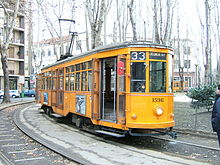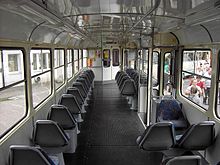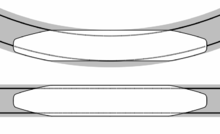Open seating car (tram)

As Greater trams , tram seating car or saloon car , commonly known as Greater tram is called in German speaking countries a certain type of tram instinctual or -beiwagen . These are about 13 to 15 meters long, mostly four-axle bogie wagons without articulation , which - mostly by means of tapered wagon ends - make maximum use of the envelope curve , have no partition walls in the interior and have closed entry platforms. In some cases, the rarer steering three- axle vehicles were also classified as open-plan cars that did not have bogies. Open-plan cars usually have three entrances / exits in the front, in the middle and in the back - representatives without a middle door are rarer.
In the GDR , combinations of three open- plan coaches were called a large train for a long time ; this designation is still common in East Germany today. Later, however, it was also used for teams consisting of three short-articulated railcars .
history
Originally, almost all tram vehicles were two-axle and therefore comparatively short; the entry platforms were initially open. Even when many companies later switched to partially or completely closed platforms, the partition walls between the entrance areas and the passenger compartment were retained. Most of the time, the passenger compartment was separated by additional sliding doors to protect the passengers from drafts.
The first four-axle tram cars - also with interior walls and partly open platforms - finally appeared at the beginning of the 20th century. These two-engine vehicles were about nine to eleven meters long and thus represented an intermediate form to the later open-plan car, but could hardly prevail over the two-axle vehicles. Examples of this are the Brandenburg trams built for the Berlin tram from 1897 and the so-called maximum multiple units , which in Germany ran in Munich, for example, from 1898 .
Only the advent of the passenger flow principle finally made it possible to manufacture even longer units, because from then on the seated conductors could handle more passengers than the classic shuttle conductors . At the same time, the industry also presented more powerful engines and control technology for four-engine vehicles and matching bogies. The Peter Witt car presented in 1914 , which is considered to be the world's first open -plan car, was particularly groundbreaking . The introduction of quick-closing, automatic exterior doors made it possible to dispense with partition walls in the interior. This made it easier for passengers to move up in the car and thus accelerated clearance. Regardless of this, more modern open-plan cars have closed driver's cabs.
Due to its tradition as vehicles with passenger flow are the most ever built Großraumwagen way vehicles . Otherwise, either two conductors' seats would have to be installed - which means that additional space for passengers would be lost in addition to the door areas opposite - or the passengers would have to get on at the front and at the back. This problem does not exist with conductors-free operation, the flow of passengers, which is mostly unpopular with passengers, could thus usually be given up again. As a rule, an open-plan car replaced a two-car train consisting of a two-axle railcar and a two-axle sidecar, which meant that only two instead of three people were required per train.
The breakthrough came with the introduction of the US PCC car in the 1930s. Relevant series in Europe were the Ventotto (from 1927), the Große Hecht (from 1929), the LM-33 (from 1933), the Swiss standard car (from 1940), the Duewag open-plan car (from 1951) and the PCC replicas of the Czechoslovak manufacturer Tatra : T1 from 1952, T2 from 1958, T3 from 1960 and T4 from 1967. Furthermore, the series V6 and V7 of the Hamburg tram (from 1949) and the Ganz UV typical of the Budapest tram (from 1956). The UV cars were delivered as one-and-a-half-direction cars and were usually used in pairs as bidirectional trains.
In western Germany , Austria and Switzerland , the open-plan cars were increasingly being replaced by the even longer articulated cars from the 1960s onwards. In these three countries the last copies went to Braunschweig in 1984 ( LHB sidecar), in 1990 to Vienna (c 5 sidecar) and in 1992 to Zurich ( Tram 2000 Be 2/4 ). In addition, in 1999 Bielefeld received five MB4 medium-sized sidecars , but these are classed as light rail vehicles.
In the former Eastern Bloc countries , on the other hand, this type of construction was used much longer. The most important representatives there were above all the Tatra wagons of various types mentioned above, this manufacturer was intended to be the main producer of tram wagons within the framework of the Comecon contracts. As the last large-capacity type, Tatra produced the T6B5 series until 2000 . In addition, the KTM-5 types dominated in the Soviet Union (built until 1992), Konstal 105Na in Poland (built until 1994) and Timiș 2 in Romania (built until 1990). The Ust-Katawer Waggonbaufabrik in Russia had an open- plan car in its range of the 71-619 until 2012.
Historic T4 train of the Frankfurt am Main tram consisting of L- railcars and L- sidecar
Relatively few Großraumwagen originated in bidirectional construction method, here are a Swiss standard car of the tram Neuchâtel
Low-floor wagons
As a rule, open- plan cars are high-floor vehicles . Most of them were built at a time when low-floor technology did not yet play such a major role or was not yet as advanced in terms of design as it is today. Nevertheless, some types have a short low-floor area between the two bogies . On the one hand, this was the case in isolated cases in the early days of this type, on the other hand, from the 1990s onwards, open-plan cars were sometimes retrofitted with a barrier-free entrance in the middle. In contrast to most low-floor articulated wagons, no design compromises are necessary in the area of the running wheels, which is sometimes difficult, especially with drive wheels. On the other hand, the low-floor area is only comparatively small, and larger differences in height have to be overcome in the smallest of spaces. In order to slightly enlarge the low-floor area, the car body was lengthened in some cases during the conversion , for example on the Tatra T3R.PLF .
An exception to the partially low-floor open- plan coaches are the consistently low-floor sidecars built between 1994 and 2002 in Leipzig (38 NB4, type 68), Darmstadt (30 SB9 ) and Rostock (22 4NBWE). These special designs are, however, only conditional to be assigned to the classic open-plan car.
Subsequently installed low-floor area at a T3R.PLF in Prague, for this purpose the former Tatra T3 was extended by a window width
Web links
- General history of open- plan cars on grossraumwagen.de ( memento from April 26, 2005 in the Internet Archive )
Individual evidence
- ↑ L-railcar on www.strassenbahn-muenchen.de
- ↑ The series 511 to 521 at www.fdas.de ( Memento of the original from October 29, 2013 in the Internet Archive ) Info: The archive link was inserted automatically and has not yet been checked. Please check the original and archive link according to the instructions and then remove this notice.











